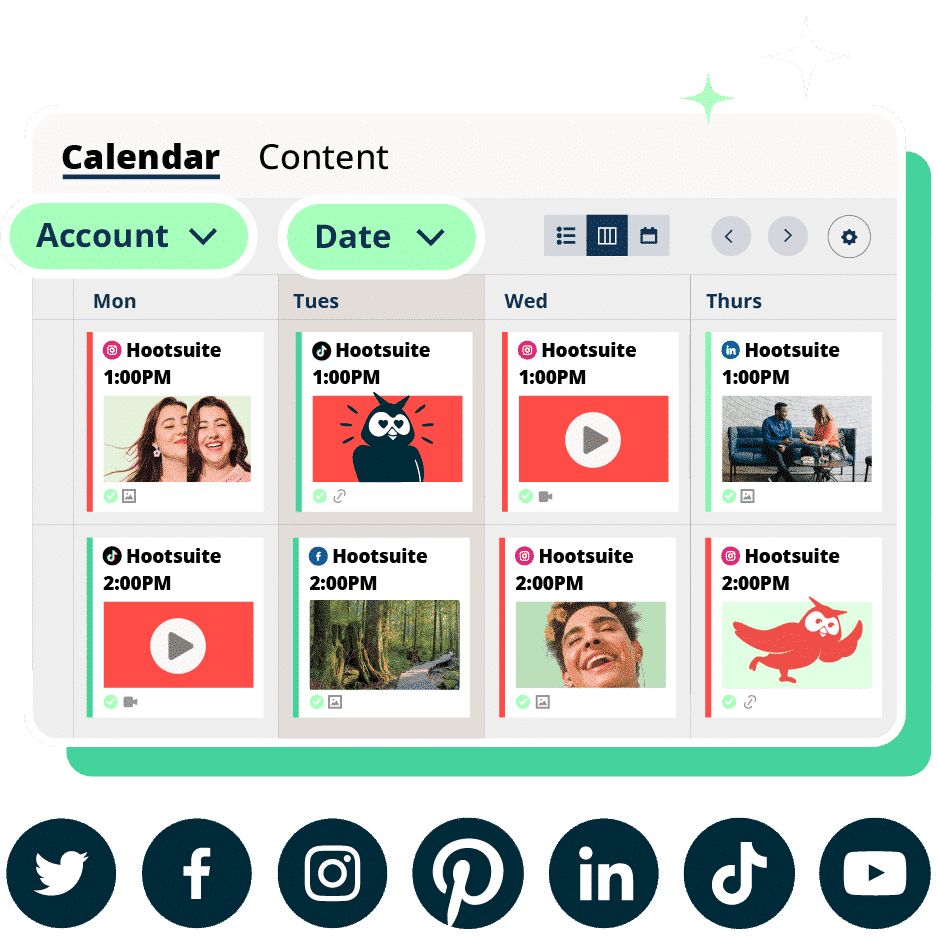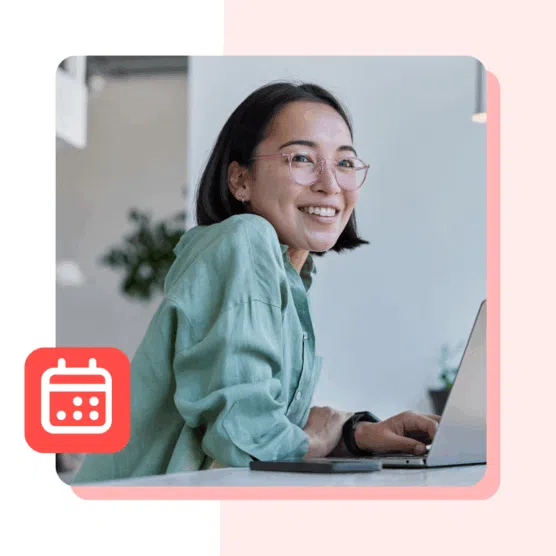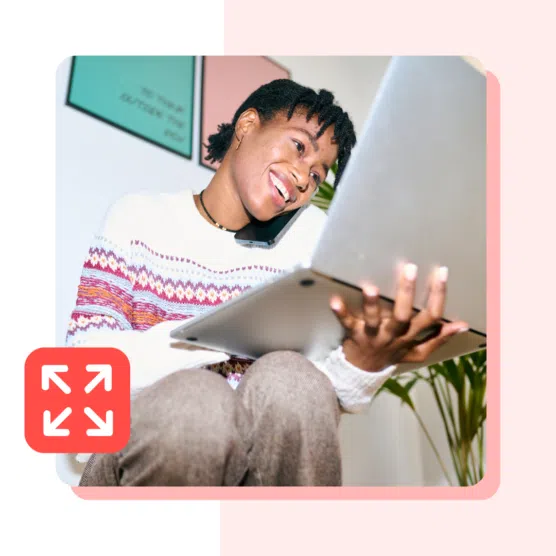Table of Contents
Wondering what the best time to post on LinkedIn is in 2025?
Social media posting times vary from brand to brand, audience to audience, but there is one thing we know for sure: if you want your posts to be seen and engaged with, you need to post them when your audience is most active.
If you don’t time your posts correctly, you’ll end up speaking to an empty room — and an empty room can’t talk back, or follow your brand, or buy your products.
The Hootsuite team partnered with data science agency Critical Truth for a comprehensive study. We analyzed over 1 million social posts — across industries and social networks — and we found the definitive best times to post on Facebook for maximum engagement.
Keep reading for the most recent available data for 9 key industries (collected in Q4 of 2024).
Note: Unless stated otherwise, the time of day was localized across 118 countries where sample data came from, i.e. the graphs below are accurate across time zones.
The overall best time to post on LinkedIn in 2025
According to our research, the best overall time to post on LinkedIn is between 8:00 AM and 9:00 AM on Tuesdays and Wednesdays.
Weekends are typically the worst days of the week to post on LinkedIn. The lower engagement may be because people view LinkedIn as a work-related social media platform and something to avoid on days off.
Planning on posting more than once or twice a week? Below is a breakdown of the best times to post on LinkedIn throughout the week, based on what the Hootsuite social team found:
When to post on LinkedIn:
- Monday: 11:00 AM PST
- Tuesday: 6:00-8:00 AM PST
- Wednesday: 9:00 AM PST
- Thursday: 2:00 PM PST
- Friday: 8:00 PM PST
- Saturday: 4:00-5:00 AM PST
- Sunday: 6:00 AM PST
The best time to post on LinkedIn by day of the week
Want to break down the best day and time to post on LinkedIn even further? Here’s what engagement looks like on the platform every day of the week.
The best time to post on LinkedIn on Monday
The best time to post on LinkedIn on Monday is 11:00 AM. It seems like people are likely to start Monday off strong with work tasks and then move on to online networking between mid-morning and lunchtime.
The best time to post on LinkedIn on Tuesday
The best time to post on LinkedIn on Tuesday is between 6:00-8:00 AM. Tuesdays are also one of the best days to post on LinkedIn throughout the week.
The best time to post on LinkedIn on Wednesday
The best time to post on LinkedIn on Wednesday is 9:00 AM. Wednesday is also one of the best days to post on LinkedIn throughout the week.
The best time to post on LinkedIn on Thursday
The best time to post on LinkedIn on Thursday is 2:00 PM. Unlike the other days of the week, Thursday sees the highest engagement in the early afternoon.
Best time to post on LinkedIn on a Friday
The best time to post on LinkedIn on Friday is 8:00 PM. This one is a little surprising, because who’s spending the end of their week on LinkedIn? Everyone, it looks like.
Best time to post on LinkedIn on a Saturday
The best time to post on LinkedIn on Saturday is between 4:00-5:00 AM. Posting early helps brands capture the attention of LinkedIn users who check the app before heading into their weekend plans.
Best time to post on LinkedIn on Sunday
The best time to post on LinkedIn on Sunday is 6:00 AM. While weekends don’t get as much engagement as business hours, early mornings are your best bet on both Saturday and Sunday.
The best time to post on LinkedIn by industry
Your industry defines your audience, and different audiences use LinkedIn on different schedules. Below, you’ll find the best times to post on LinkedIn across 9 major industries.
Note: Time of day was localized across 118 countries where sample data came from, i.e. the graphs are accurate across time zones.
Construction, mining, and manufacturing
According to our research, LinkedIn engagement is quite consistent from Monday to Friday in the construction, mining, and manufacturing industry. That said, the following times tend to generate the highest engagement:
- 2 pm to 4 pm on Mondays
- 10 am on Tuesdays
- Early mornings (before 6 am) on Thursdays
- 3 pm on Fridays

Dining, hospitality, and tourism
The best time to post on LinkedIn in the dining, hospitality, and tourism industry is 12 pm on Wednesdays.

Education
The best times to post on LinkedIn in the education sector are:
- 9 am on Wednesdays
- 11 am to 1 pm on Fridays

Financial services
For financial services institutions, the best times to post on LinkedIn are:
- 5 pm on Mondays
- 1 pm on Wednesdays
- 5 pm to 7 pm on Thursdays
- 11 am to 1 pm on Fridays

Government
According to our research, government agencies and officials generate pretty consistent LinkedIn engagement from Monday to Saturday. That said, there are some sweet spots:
- 3 pm on Mondays
- 9 am to 11 am on Tuesdays
- 10 am on Wednesdays
- 11 am to 1 pm on Saturdays

Healthcare
The best time for healthcare institutions and professionals to post on LinkedIn is 9 am to 1 pm Tuesday through Friday.

Nonprofit
The best times for nonprofit organizations to post on LinkedIn are:
- 11 am to 2 pm on Tuesdays
- 12 pm to 3 pm on Wednesdays
- 11 am on Saturdays

Real estate, legal, and professional services
For professional services, including legal and real estate, the best times to post on LinkedIn are:
- 8 am to 10 am on Thursdays
- 10 am to 1 pm on Saturdays

Technology
The best time to post on LinkedIn in the technology industry is 11 am on Mondays.

The best time to post on LinkedIn by time zone
CET
In Central European Time, the best time to post on LinkedIn is 7 pm on Thursdays.

CST
In Central Standard Time, the best times to post on LinkedIn are:
- Early Tuesday mornings (before 6 am)
- 6 am on Thursdays
- 4 pm on Fridays

EST
The best times to post on LinkedIn in EST are:
- 5 am on Tuesdays
- 6 am and 5 pm on Thursdays
- 8 am and 6 pm on Fridays

GMT
In Greenwich Mean Time, the best time to post on LinkedIn is 7 am to 9 am on Thursdays.

MST
In Mountain Standard Time, the best times to post on LinkedIn are 5 am and 3 pm on Thursdays and Fridays.

PST
The best time to post on LinkedIn in Pacific Standard Time is 2 pm to 4 pm on Thursdays and Fridays.

Why does timing matter when posting on LinkedIn?
Timing matters when posting on LinkedIn because in order for your audience to engage with your content, they have to see it.
If you post at a time when they are unlikely to be online, LinkedIn’s algorithm, which uses member activity as a ranking factor, may not prioritize your post in users’ feeds. This means your LinkedIn content could get buried before your audience even has a chance to interact with it.
As well, in early 2024, LinkedIn introduced “suggested posts,” a new feature that keeps important posts visible in feeds long after they’re posted. This marks a significant shift from the traditional newsfeed approach, and is part of LinkedIn’s effort to match content with users’ interests, rather than just showing the latest updates.
What does this mean for you? Well, if promoted to a suggested post, your posts could have a longer lifespan and more chances to get in front of user’s eyeballs — even weeks or months after posting. “It’s the latest step in our ongoing efforts to emphasize knowledge and advice over mere virality,” Tim Jurka, LinkedIn’s Senior Director of Engineering, told Entrepreneur magazine.
So, what does this mean for the best time to post to LinkedIn? Well, choosing the right posting time still matters. And here’s why:
Algorithm favourability: Timely posts that garner quick engagement are more likely to be promoted by LinkedIn’s algorithm, increasing their reach.
Visibility: Posting when your audience is active increases the chances of your content being seen in their feeds, and being engaged with.
Engagement: Higher engagement shortly after posting can signal to LinkedIn’s algorithm that your content is valuable, potentially leading to broader visibility as a suggested post.
What affects the best time to post on LinkedIn?
Even once you have the best time of day to post on LinkedIn locked in, there are other, outside considerations, that can affect your post’s performance.
Here’s a breakdown.
Your unique audience
Just like every business has its own unique identity and goals, each businesses audience on LinkedIn is distinct. Their online habits, influenced by profession, interests, and time availability, dictate when they are most active. For instance, professionals in technology might engage more during weekdays, whereas creative industries might see more activity during evening hours.
Since no two audiences are exactly alike, you’ll need to do your research on what times are best for you to post.
Remember when we said that Tuesdays and Wednesdays are the best universal times to post on LinkedIn? Well, they do work for many businesses — but here at Hootsuite, we zeroed in on different times that work best for our audience.
Trish Riswick, Hootsuite’s Social Media Team Lead, spilled the tea: “Over the past few months, I’ve noticed that posting to the Hootsuite LinkedIn account on Mondays and Fridays generates the best performance.”
Trish also emphasized that experiments are the key to finding your optimal posting schedule.
“[Last year] I was posting on LinkedIn primarily before 12 pm PST. One time, after forgetting to get something out at noon, I posted an update at 2 pm and… it did great. Since then, I’ve noticed a positive increase in engagements at that time throughout the week. This just goes to show that you need to keep testing different schedules and monitoring what works for you and your content.”

To find out when your audience is most engaged, dive into your LinkedIn Analytics tool. Look for patterns in when your posts receive the most likes, comments, and shares. This data will help you pinpoint the times that work best for your specific audience.
Pro tip: Use Hootsuite Analytics to see all of your Linkedin post data, plus competitor benchmarking and best time to post data based on your unique audience.
Your industry
Different industries have different rhythms when it comes to social media engagement. What works for a tech startup may not necessarily resonate with a healthcare provider or a fashion brand. Understanding these nuances requires a keen eye on industry-specific trends and consumer behaviors.
Not sure where to start? A little social competitive analysis never hurt anyone. Lurking at your competitors’ profiles can give you an idea of what they consider the best times to post. If the products or services you offer are similar, your audiences might overlap — and you can learn from your competition’s findings, skipping the trial and error.
Check out the post below to learn what kind of engagement you can expect on LinkedIn.
Pro tip: You might notice that many brands schedule their posts to go live right on the hour mark. To avoid the competition, try posting a few minutes before or after the :00.
The LinkedIn algorithm
LinkedIn’s algorithm prioritizes posts that generate immediate engagement — likes, comments, and shares — shortly after they’re posted. This means that the initial response to your post plays a crucial role in determining its visibility and reach across the platform.
To optimize your posts for LinkedIn’s algorithm, focus on creating content that encourages immediate interaction from your audience. Timely and relevant posts tend to perform better, as they align with current discussions and trends within your industry. By posting when your audience is most active and likely to engage, you can increase the chances of your content being prioritized by LinkedIn’s algorithm and reaching a broader audience.
Pro tip: Not sure what to post? Here’s 12 LinkedIn post ideas you can have for free. Plus, try Hootsuite’s LinkedIn post generator to cut your content sourcing time in half.
Time zone considerations
LinkedIn users span the globe, so posting at times that work across different time zones can widen your reach. For instance, posting early in the morning from a PST time zone (say, 5 AM PST) might catch both West Coast and East Coast audiences when they’re getting up for work.
If you’re an international brand, make sure you are posting in your target audience’s time zone. This should go without saying, because your audience won’t see your post or interact with it when they’re asleep.
Pro tip: Using a social media management tool to schedule your posts in advance will help you get your LinkedIn posts live at the right time, no matter where you are located. In other words, if your best time to post happens to be 6 AM on a Tuesday, you won’t have to set an alarm.

Current events and trends
Posting about hot topics or industry events shows you’re in the know and keeps your content relevant. It’s like joining a conversation that everyone’s buzzing about. For example, if there’s a big tech conference or a new industry report out, posting related content can position you as a thought leader and get more eyes on your posts.

Social listening tools that keep track of trends and hashtags can help you stay ahead — like Hootsuite. By knowing what’s trending, you can tweak your content to fit your audience’s interests at the perfect time.

Just remember, while planning your LinkedIn posts around hot topics can be effective, make sure your content actually adds value to the conversation. This ensures your posts don’t just ride the wave of popularity but also genuinely contribute to your audience’s professional knowledge and interests.
How to find your unique best time to post on LinkedIn with Hootsuite
Figuring out when to post on LinkedIn for maximum impact is easier with Hootsuite. Use these tools to nail down the best times to share your content and boost your LinkedIn strategy.
Best Time to Publish
Hootsuite’s Best Time to Publish feature takes the guesswork out of scheduling your LinkedIn posts. It looks at how your audience has engaged with your past posts to recommend the times they’re most active.
Here’s how to use it:
Go to your Hootsuite dashboard and click on Analytics.

Select Best Time to Publish from the menu on the left.

Pick your LinkedIn account from the list to see when your audience is most likely to engage.

Now, you’ll get customized heatmaps showing the best days and times to post based on your audience’s habits. Hootsuite pinpoints the specific times when your LinkedIn posts will get the most likes, comments, and shares, tailored to what works best for your audience.
Recommended Times in Composer
When you’re ready to create a post, Recommended Times in Composer helps you decide when to post right from your draft.
Here’s how:
Start drafting your LinkedIn post in Hootsuite Composer. Add your content, images, hashtags, and anything else.

Click on Schedule for later at the bottom right.

Hootsuite suggests the best times to publish, based on when your audience is most active and how your previous posts have performed. Choose one of the recommended times or set a custom time that fits your LinkedIn strategy.

Easily manage your LinkedIn Page alongside your other social channels using Hootsuite. From a single platform you can schedule and share content—including video—engage your network, and boost top-performing posts.








